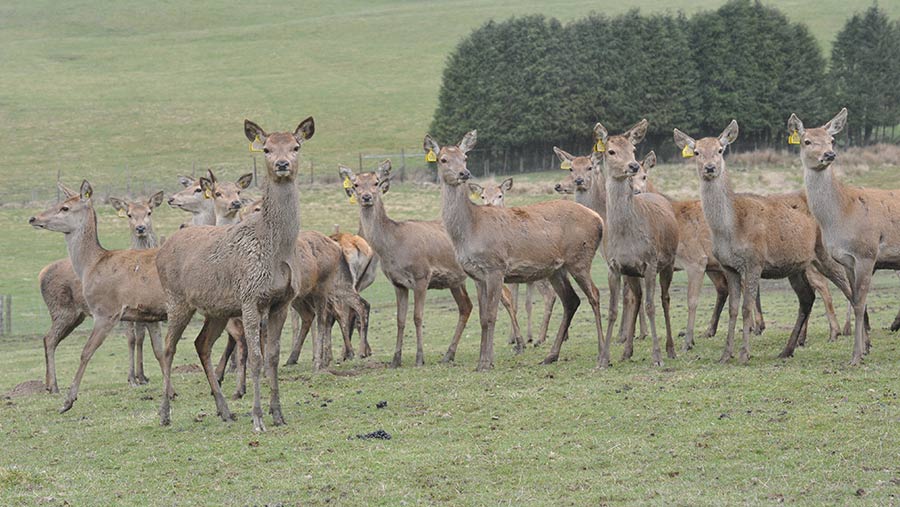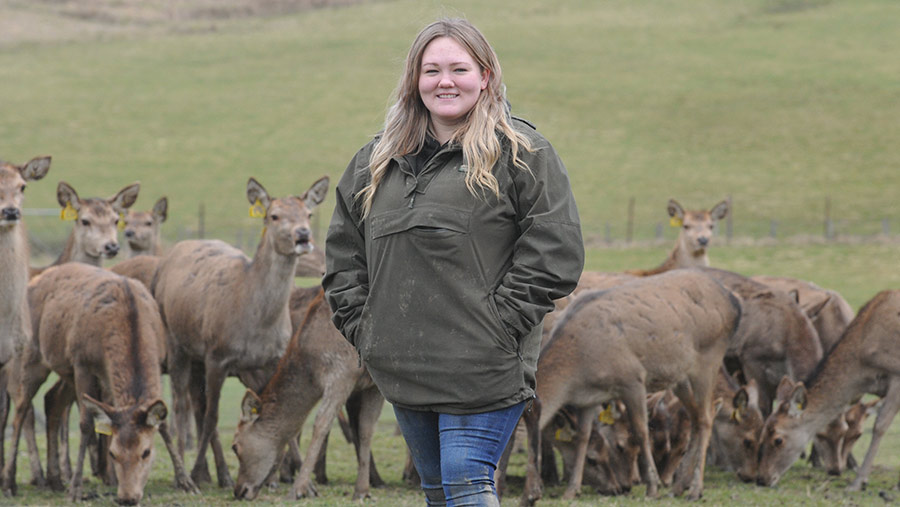Why deer diversification is a good fit for Welsh hill farm
 © Debbie James
© Debbie James When the Williams family ventured into venison production, a chief consideration was how it would integrate into their existing beef and sheep enterprises.
It meant reducing the sheep flock by 200 ewes to create a dedicated 26ha (64-acre) grazing area for the deer, but with a higher-value product, the economics favoured venison.
Three years on, and the Williamses say the new enterprise is helping them to make the best use of farm and labour resources as the key production stages in the three systems complement each other.
See also: How a Cornish farm set up on-farm deer processing facilities
Planning for the future
The principal reason for the new venture was to create a business model that would generate sufficient income for two families, as farmers Keith and Ali Williams were joined by their daughter, Becca, at Hendy, a 160ha (400-acre) upland farm at Hundred House, Llandrindod Wells.
The major reasons why they considered deer were the low labour requirements and minimal handling and birthing problems.
“We felt deer would reduce our exposure to the sheep market and would fit well around the busier times of beef and sheep farming,” explains Mr Williams.
After a great deal of research, which included visiting established commercial deer farms, they took the plunge in 2019.
They invested £100,000 in fencing and handling facilities and bought 80 young hinds and two stags from UK deer farms.
They run these as two herds, with one stag to 40 hinds. The stags cost £2,000 a head compared with an average of £250 for the hind calves, but they have an estimated working life expectancy of 10 years.
Changing mindset and farm infrastructure
The family quickly realised that farming deer needed a different mindset to how they ran their sheep and cattle.
“It was about changing our mentality as much as anything else,” admits Miss Williams.
“For example, we will work a dog behind the sheep when we are moving them, but you can’t do that with deer.
“The deer will also always run along the fence line when you try to move them. It’s all those things we had to get used to,” she adds.
Deer also require much greater containment than beef and sheep. Fencing needs to be at least 2m high and well maintained – a reason why the setup cost of £10/m for full-height deer fencing in 2019 was so high.
“If a deer escapes, it is unlikely that you will see it again, so you have to be absolutely certain they can’t get out,” Mr Williams points out.
Gates were positioned in corners, where possible, to create a funnel, making it easier for the deer to see them.
For handling, a drop-floor crush specific to deer was purchased. The crush has tapered sides and the floor is released after a deer walks into the crush, allowing it to be held securely by the sloped sides.
Farm facts
- 160ha (400-acre) upland farm
- 700 cross-bred ewes and 180 ewe lambs
- 23 Welsh Black suckler cows
- 80 young hinds and two stags plus youngstock
- Lamb and beef sold to Waitrose
- Income from agreements for two 2MW wind turbines

Becca Williams © Debbie James
Management
Fencing and handling aside, in nearly every other management aspect deer are easier to farm than sheep or cattle, Miss Williams says.
This is largely a consequence of the farmed animal being just a few generations removed from the wild so, for example, any issues with breeding have been dealt with through natural selection.
The hinds calve at grass in June and July. Calves stay with their mothers until weaning at five to six months old, after the rutting season, and they are housed in a cattle shed fitted with netting.
Enrichments, including yoga balls, have been introduced to deter bullying.
“It distracts them – if they get grumpy, they take that aggression out on the balls instead of each other,’’ she explains.
Silage is fed in troughs during housing – ideally at 10.5MJ/kg metabolisable energy – alongside 0.25kg a head a day of concentrates.
Hinds and stags are outwintered on hay and fed a minimal concentrate to help with management.
“They get to know what a bag means so it helps when we need to round them up,” says Mr Williams.
Youngstock are turned out to grass at the beginning of April, just before the ewes are housed for lambing.
In their first calving season, a pregnancy rate of 50% is expected. This was the case in both herds at Hendy, but at the second calving, this increased to 90% in one herd and 75% in the other.
Health
Deer have very few health issues – they do not suffer from foot-rot, fly strike or mastitis.
Although the family have had no cases, deer can suffer from cryptosporidium, which can build up on the ground during calving.
The only health interventions are a copper bolus administered once a year before breeding, alongside worming, if required, and a flukicide when the calves are weaned in December.
The biggest health concern is bovine TB – Hendy is in a high-risk area and although there is not a requirement for the deer to be tested, that would change if there was a disease breakdown in the suckler herd.
De-antlering needs to be done once a year, in the late summer or early autumn, when the velvet, or furry skin, that covers them has rubbed off.
Sales and payback
There are now 63 animals destined for slaughter in September and October 2023.
They will be sold to Dovecote Park to supply Waitrose.
The Williamses had hoped to sell some of the meat direct to add value over and above the £6/kg deadweight they are paid by their processor, but this would mean hiring the abattoir purposely for that.
“The regulations don’t allow for deer to be slaughtered in the same kill as other livestock, so we would have to hire out the entire slaughterhouse and pay for a vet to be present – it just wouldn’t be financially viable for two or three deer,” says Mr Williams.
But with a strong market price, he calculates that the initial investment will have a seven-year payback.
At 80 hinds, numbers are at a level that sits well with the other enterprises at Hendy. To expand numbers, additional suitable land would be required.
“The 64 acres [25ha] where the deer are now works well because it doesn’t involve any rights of way, [whereas] our other land does and that wouldn’t work with deer,’’ says Mr Williams.
